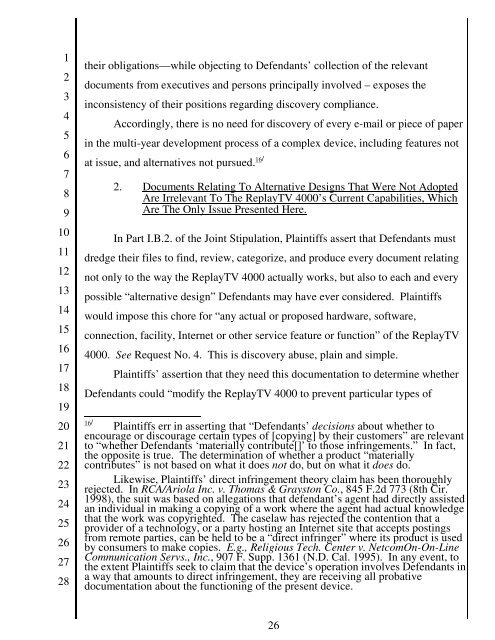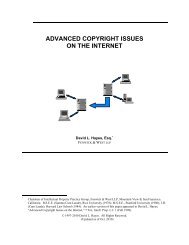Paramount Pictures Corporation v. ReplayTV, Inc., Joint Stipulation ...
Paramount Pictures Corporation v. ReplayTV, Inc., Joint Stipulation ...
Paramount Pictures Corporation v. ReplayTV, Inc., Joint Stipulation ...
You also want an ePaper? Increase the reach of your titles
YUMPU automatically turns print PDFs into web optimized ePapers that Google loves.
12345678910111213141516171819202122232425262728their obligations— while objecting to Defendants’ collection of the relevantdocuments from executives and persons principally involved – exposes theinconsistency of their positions regarding discovery compliance.Accordingly, there is no need for discovery of every e-mail or piece of paperin the multi-year development process of a complex device, including features notat issue, and alternatives not pursued. 16/2. Documents Relating To Alternative Designs That Were Not AdoptedAre Irrelevant To The <strong>ReplayTV</strong> 4000’ s Current Capabilities, WhichAre The Only Issue Presented Here.In Part I.B.2. of the <strong>Joint</strong> <strong>Stipulation</strong>, Plaintiffs assert that Defendants mustdredge their files to find, review, categorize, and produce every document relatingnot only to the way the <strong>ReplayTV</strong> 4000 actually works, but also to each and everypossible “ alternative design” Defendants may have ever considered. Plaintiffswould impose this chore for “ any actual or proposed hardware, software,connection, facility, Internet or other service feature or function” of the <strong>ReplayTV</strong>4000. See Request No. 4. This is discovery abuse, plain and simple.Plaintiffs’ assertion that they need this documentation to determine whetherDefendants could “ modify the <strong>ReplayTV</strong> 4000 to prevent particular types ofPlaintiffs err in asserting that “ Defendants’ decisions about whether toencourage or discourage certain types of [copying] by their customers” are relevantto “ whether Defendants ‘materially contribute[]’ to those infringements.” In fact,the opposite is true. The determination of whether a product “ materiallycontributes” is not based on what it does not do, but on what it does do.Likewise, Plaintiffs’ direct infringement theory claim has been thoroughlyrejected. In RCA/Ariola <strong>Inc</strong>. v. Thomas & Grayston Co., 845 F.2d 773 (8th Cir.1998), the suit was based on allegations that defendant’ s agent had directly assistedan individual in making a copying of a work where the agent had actual knowledgethat the work was copyrighted. The caselaw has rejected the contention that aprovider of a technology, or a party hosting an Internet site that accepts postingsfrom remote parties, can be held to be a “ direct infringer” where its product is usedby consumers to make copies. E.g., Religious Tech. Center v. NetcomOn-On-LineCommunication Servs., <strong>Inc</strong>., 907 F. Supp. 1361 (N.D. Cal. 1995). In any event, tothe extent Plaintiffs seek to claim that the device’ s operation involves Defendants ina way that amounts to direct infringement, they are receiving all probativedocumentation about the functioning of the present device.16/26
















